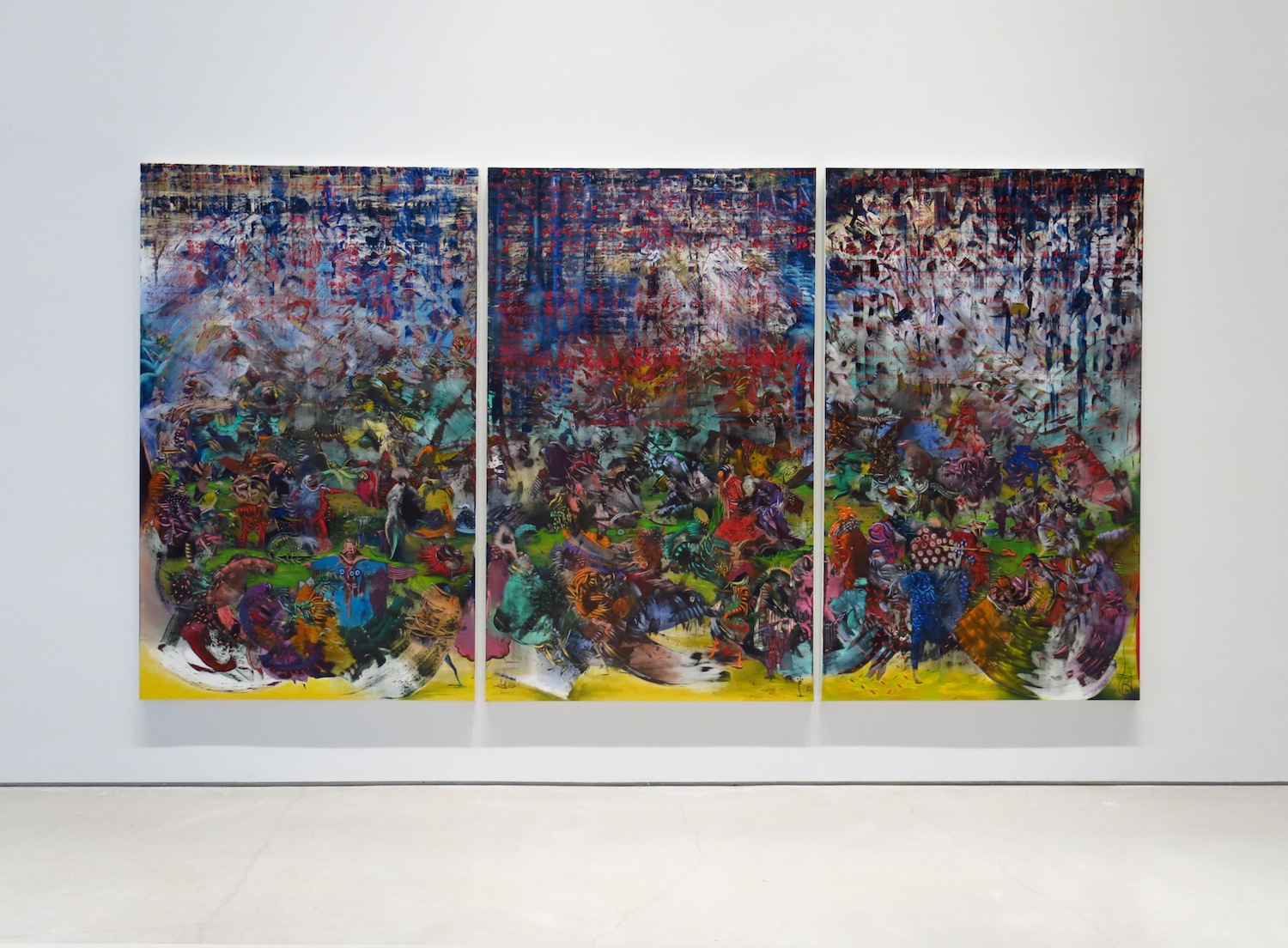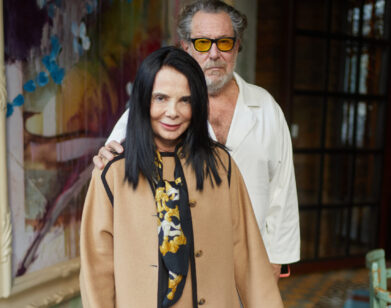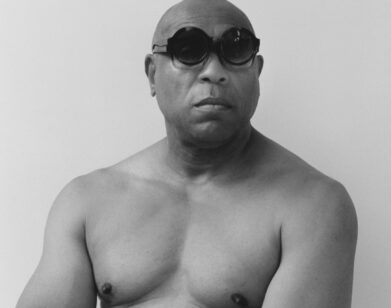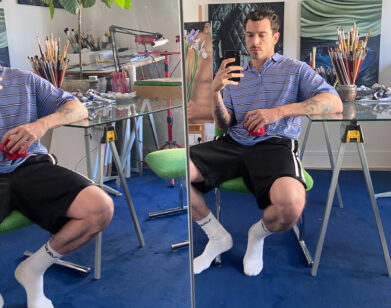How Ali Banisadr Holds Memory
Bombs blasted, houses crumbled, people in gas masks darted throughout the streets: it was one of the 20th century’s most violent wars. While contemporary artist Ali Banisadr was born in Iran in 1976—four years before the outbreak of the eight-year Iran-Iraq war—his upbringing is less of an influence than one might think.
“At the beginning I was trying to think about the actual war—why did it happen and what was involved? But then the conversation expanded,” Banisadr says. His Iranian background looms in the subconscious, while consciously he draws inspiration from everyday encounters: political affairs, books, and recent works of art as well as historical events and art history. Art, for Banisadr, is more than a language. It is a visual philosophy.
“Words are limiting,” he explains. “Visual philosophy is how I deal with questions in life. I can deal with things that I can’t describe in words.”
The more time spent in front a Banisadr painting, the more a work unveils itself. What at first glance appear to be abstract lines and whimsical dots begin to morph into characters that create narratives. Hidden creatures appear in the depths of canvases, and wide brushstrokes attain new significance. Kandinsky’s cubism meets Brueghel’s landscapes; pure abstraction becomes deliberate form.
Just as the viewer becomes lost within his organized chaos, the same is true for Banisadr himself. “As I look at the older works, I start to understand things more,” he says. “I have to let it settle to understand what’s happening.”
Banisadr’s family left Iran in 1988, first moving to Turkey and then to California. In 2000, Banisadr moved to New York, where he still lives and works. On March 1, a solo show featuring his most recent paintings—the largest of which he completed this week—will open at the Sperone Westwater Gallery on the Lower East Side.
Before the official opening, Banisadr guided us through the exhibition, where we spoke about his synesthesia, love of books, and his relationship with technology, while avoiding the tired topic of his Iranian background.
EMILY MCDERMOTT: One of the most fascinating things I read was how you work with sound, how you hear sound and let that guide you through your painting.
ALI BANISADR: I’ve known about that since I was a kid. My mom says that when the Eight Years’ War was happening I would draw to create a visual understanding of the sounds I was hearing—the vibrations, explosions, and air raids. It was automatic. I never really thought about it, [but] then it was something I was fascinated by. Before I went to art school, I studied psychology for that reason. I was trying to understand why, when I do something visual, do I hear a sound? Or why when I eat something there’s a color? I didn’t know there was a name for it—synesthesia. Reading about it and about Kandinsky talking about it was interesting. It was driving me to tap into my imagination and understand why senses are mixed.
MCDERMOTT: Do you find synesthesia in other parts of your life?
BANISADR: It’s mostly sound and visual, but say someone tells me their name—that name can turn into a taste or a color and that’s how I categorize it in my mind. It’s an easy way of categorizing things, but it’s mostly about composing the work. It’s this sound that guides me to press harder on the brush and lift off, or let go or stop there and then continue there. It’s a guidance.
I never think about actual things when I’m painting. I’m not thinking, “I’m going to put a person here, a tree here and a bird there.” The beginning stage is always the sound. From that, slowly, stories come about based on what I’m reading or thinking at the time, but if I didn’t have that sound I don’t know what I would do.
MCDERMOTT: You said a lot of your inspirations are what you’re reading or what’s happening at the moment, but what are some things you find yourself always referring to?
BANISADR: It’s always a combination of what I’m reading, current events, artwork that I’ve seen, films and music. As I work day after day, inspirations from different places go into the work. It’s combination, but it’s also comparative. I’ll be reading two books at the same time that are totally different [and] then have two stories mix together.
MCDERMOTT: What’s an example of that happening?
BANISADR: I was reading Kandinsky’s Concerning the Spiritual in Art and at the same time I was reading this book that’s coming out—my work is on the cover—called The Last Illusion, by Porochista Khakpour. It’s this story like Iran’s The Odyssey, [but] put in the modern day, pre-9/11. It’s surreal. I was reading that, Kandinsky, and re-watching my Kurosawa films. The painting downstairs is titled Ran, which is a Kurosawa film, but this [looking at Contact] is called Contact because of the tension between two characters.
MCDERMOTT: Were you feeling a tension in your life when you painted Contact?
BANISADR: I was trying to protect this person who is a metaphor for myself. I felt there was a danger coming and danger did come… I moved into a new place and a light fixture fell and cut my hand. [shows scar] I got five stitches and couldn’t paint for 10 days.
[moves to another painting]
This one is called Aleph, which, talking about books, was inspired by Borges.
MCDERMOTT: I just read that last week.
BANISADR: It’s fascinating to me, that room where every point in the universe meets and you see everything from every angle. That’s a metaphor for the way my paintings are made. I want the viewer to see everything from every angle. It’s cubism; it’s Persian Miniature paintings. Persian Miniature paintings are cubist—everything is flipped up. I love the [Borges] story, but at the same time I use the title to describe my paintings, they way they’re painted, and what they’re trying to show. I don’t have a focal point in the work. Every part of the painting is important. There’s no hierarchy.
MCDERMOTT: An interesting part of the story I thought about was whether or not everyone has the same vision when they see everything in the universe converge. What do you think?
BANISADR: I think everybody brings in his or her own fears, anxieties, and background. As a painter, that’s interesting to hear what other people see in the work, what it means and where it takes them. I think [my art] is a visual, universal language. Of course, when Iranians or Middle Easterners see it, they automatically see their history, but then there’s everything else. When I was taking art history I was always angry that we would skip certain chapters because “it wasn’t important.” Like, “Let’s skip over the Japanese. Let’s just get to Giotto, because that’s where everything begins.” It’s like, no. Everything is relevant to me.
MCDERMOTT: How long does it take you to usually make a painting?
BANISADR: For something like Contact, it could take about a month and a half, but it all depends. The smaller ones could take just as long, because sometimes they’re actually harder. I work until they are finished, one at a time. I could never go from this to that at the same time. They’re different worlds, different conversations. It takes so long to connect to the work. It might take three or four hours of sitting and looking, then slowly things start to come about.
MCDERMOTT: That makes sense. There are so many layers.
BANISADR: There are a lot of layers, and adding and subtracting as well. At the end, some parts could be just white canvas and some parts could be super thick. It’s like creating holes or worlds within worlds.
MCDERMOTT: Some of it even looks three-dimensional. How would describe your work to someone who had never seen it?
BANISADR: It’s good to give people a reference. I always say kind of like a Brueghel-Bosch world because it has that bird’s-eye view, but the paint handling is more abstract, like De Kooning. It’s landscape, but not really. I like when there’s a fight between deep space and flat space.
MCDERMOTT: How would you describe your philosophy toward art?
BANISADR: For me, my work makes people understand things in a visual way that I could never understand in a literal way—like the way you deal with and break down problems, and don’t come up with answers, but [find] a pathway that becomes clearer. If I have certain philosophical questions, dealing with them in a visual way is how it gets solved. A chemist could handle it in their lab; I handle it on the surface of the canvas.
MCDERMOTT: What’s one of those questions you’ve dealt with in your works?
BANISADR: I’m fascinated by how systems function, be it religious, corporate, or political. When I deal with it visually, breaking down systems makes me at ease. That’s why the work is always from a bird’s-eye point of view. You’re looking at worlds within worlds, but as a whole it’s a system functioning. To me, not getting caught up in a political situation—Republican, Democrat, whatever—is having that bird’s-eye view. I like to zoom out of the situation so I can see it all and don’t get caught up in the little things down there.
MCDERMOTT: That’s so hard to do, to remove yourself from situations.
BANISADR: It is, and so many people are down there in this maze talking about things that in the big picture don’t matter. You could argue about something for forever, but all that argument comes down to is what channel news you watch and what channel news I watch.
I constantly think about these issues. I sometimes say the conflict in the work is the conflict of my own thoughts and anxieties. It’s a civil war in my head. The top part [of my artwork] is you letting go and floating. You become part of the air and you’ve tapped into the heartbeat of the universe. All of these problems go away. I guess that’s what people do when they meditate.
MCDERMOTT: Do you do something that allows you to…
BANISADR: This is it. This is the meditation part. I go to my studio, and time disappears. Sometimes I forget where I went and how decisions were made. I could never say how I made something because I make a thousand decisions in eight or nine hours. You can’t remember how it happened. It just does. It’s a gut instinct.
MCDERMOTT: Have you ever had a moment where you’ve stepped away from your painting and come back and are like, “Wow. I didn’t even realize I did that”?
BANISADR: All the time. It’s an interesting painting process. [laughs] Sometimes I forget what I put in. If you try to remember someone or an experience, it always changes in your mind. They’re never static. I want to capture things in that way, where you’re looking into your memory, a dream or hallucination. The characters become a mixture of archetypes, [and] that’s what I like. You’re trying to figure it out and your brain wants to categorize things, but it can’t because of this motion. You want to solve the problem, but it never gets solved. It’s like when you read a really good book and the story never leaves you.
MCDERMOTT: Do you have one of those books?
BANISADR: I have plenty. I would say Orhan Pamuk is one of my favorite authors. He’s really famous for his work Snow, but I like My Name is Red. There are many things that happen in the story, but the way it’s written is like every character is speaking to the reader. You’re the judge of what’s happening in the story… it’s a puzzle. Everything is fragmented and you’re supposed to put it together.
MCDERMOTT: You can see that reflected in your work.
BANISADR: Exactly. When I was reading it I was like, “That’s it!” He’s Turkish, and he used to be a painter himself. But of course I love Borges and Umberto Eco. There’s a lot. [laughs]
[moves to other paintings]
MCDERMOTT: Should we talk about “Motherboard”?
BANISADR: A motherboard is this chip with different compartments that work together in order for the whole thing to function. In my work it’s the same thing—every little dot and line has to function for the whole work to activate. Another reason [for “Motherboard”] was the fact that it holds memory. I don’t use references in my work. It’s very visceral and organic, coming from memory.
“Motherboard,” for me, has four different levels: the bottom part is the water, vegetation, and growth. The second part is the world with figures and animals; there’s chaos and civilization. The third part is the digital zone—these red things [points to painting] are turning into really loud digital sounds. [makes sound] Remember AOL, back in the day, when you would log in? Then the fourth level is like ether and things turning into air. This idea of how we’re becoming partly digitalized is really interesting to me.
MCDERMOTT: What do you think of technology and the way it’s progressed?
BANISADR: I think it’s scary. 1984 is another favorite—all of those things are happening. Your phone has become part of your hand and if you don’t have it, you don’t know what to do. What’s going to happen later? A new generation of kids, if they didn’t have their electronics, what would they do? This is not something that’s happening everywhere in the world. I was observing in Paris. Nobody’s on their phone. Everybody’s sitting the café with their actual newspaper, little espresso and cigarette. But here, and in China and Japan, it’s insane.
MCDERMOTT: Have you seen technology change your work?
BANISADR: I think in a way it has influenced my work. Think about the way you go surfing on the Internet—you go from one thing to another. You can’t really concentrate. I can’t sit and read 10 pages on my computer. You’ll read and then all of a sudden part of your brain is like, “What about that? And oh, Facebook.” Things keep going from one to another. Borges talked about the Library of Babel, which is the Internet, really, except you’re not reading the whole book. You’re reading fragments. Even though I think it’s bad, I think it’s interesting too, because that’s the way my brain works.
MCDERMOTT: And how do you feel about the Internet and images representing your work?
BANISADR: It doesn’t do it justice. People quickly look through things and don’t sit and experience. That’s a problem with artwork, [because] it’s more of an experience than something to quickly look at. It takes a while for everything to unveil itself. It’s a very slow process, and the way I work is a very slow process. The way a person views it should also be a very slow process. So, it’s about making you look more—not just [at] the paintings, but at life in general.
“ALI BANISADR: MOTHERBOARD” IS ON VIEW AT SPERONE WESTWATER GALLERY MARCH 1 THROUGH APRIL 19.







